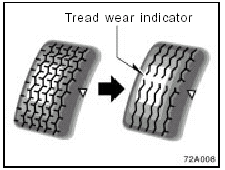 Toyota Yaris: Checking and replacing tires
Toyota Yaris: Checking and replacing tires

CHECKING YOUR TIRES
Check the tire’s tread for tread wear indicators. If the indicators show,
replace the tires. The location of tread wear indicators is shown by the “TWI” or
“ ” marks, etc., molded on the sidewall of
each tire.
” marks, etc., molded on the sidewall of
each tire.
The tires on your Toyota have built-in tread wear indicators to help you know when the tires need replacement.
When the tread depth wears to
1.6 mm (0.06 in.) or less, the indicators will appear. If you can see the indicators
in two or more adjacent grooves, the tire should be replaced.
The lower the tread, the higher the risk of skidding.
The effectiveness of snow tires is lost if the tread wears down below 4 mm (0.16 in.).
If you have tire damage such as cuts, splits, cracks deep enough to expose the fabric, or bulges indicating internal damage, the tire should be replaced.
If a tire often goes flat or cannot be properly repaired due to the size or location of a cut or other damage, it should be replaced. If you are not sure, consult with your Toyota dealer.
If air loss occurs while driving, do not continue driving. Driving even a short distance can damage a tire beyond repair.
Any tires which are over 6 years old must be checked by a qualified technician even if damage is not obvious.
Tires deteriorate with age even if they have never or seldom been used.
This applies also to the spare tire and tires stored for future use.
REPLACING YOUR TIRES
When replacing a tire, use a tire of the same size and construction, and the same or greater maximum load as the originally installed tires.
Using any other size or type of tire may seriously affect handling, ride, speedometer/odometer calibration, ground clearance, and clearance between the body and tires or snow chains.
Check that the maximum load of the replaced tire is greater than 1/2 of the Gross Axle Weight Ratings (GAWR) of either the front axle or the rear axle, whichever is greater. As for the maximum load of the tire, see the load limit at maximum cold tire inflation pressure mentioned on the sidewall of the tire, and as for the Gross Axle Weight Ratings (GAWR), see the Certification Label.
For details about the sidewall of the tire and the Certification Label.
CAUTION.
Observe the following instructions.
Otherwise, an accident may occur resulting in death or serious injuries.
Do not mix radial, bias belted, or bias-ply tires on your vehicle, as this may cause dangerous handling characteristics resulting in loss of control.
Do not use tires other than the manufacturer’s recommended size, as this may cause dangerous handling characteristics resulting in loss of control.
Toyota recommends all four tires, or at least both of the front or rear tires be replaced at a time as a set.
See “If you have a flat tire” for tire change procedure.
When a tire is replaced, the wheel should always be balanced.
An unbalanced wheel may affect vehicle handling and tire life. Wheels can get out of balance with regular use and should therefore be balanced occasionally.
When replacing a tubeless tire, the air valve should also be replaced with a new one.
 Checking tire inflation pressure
Checking tire inflation pressure
Keep your tire inflation pressures at the proper level.
The recommended cold tire inflation pressures, tire sizes and the combined weight
of occupants and cargo (vehicle capacity weight). They ...
 Rotating tires
Rotating tires
To equalize the wear and help extend tire life, Toyota recommends that you
rotate your tires according to the maintenance schedule.
(For scheduled maintenance information, please refer to the “ ...
See also:
Engine (ignition) switch
■ Starting the engine
Vehicles with an automatic transmission
Check that the parking brake is set.
Check that the shift lever is set in P.
Firmly depress the brake pedal.
Turn the ...
Engine immobilizer system
The engine immobilizer system is a theft prevention system. When you insert
the key in the ignition switch, the transponder chip in the key’s head transmits
an electronic code to the vehicle.
...
Checking the radiator and condenser
If any of the above parts are extremely dirty or you are not sure of their condition,
take your vehicle to a Toyota dealer.
CAUTION.
To prevent burning yourself, be careful not to touch the radiat ...
